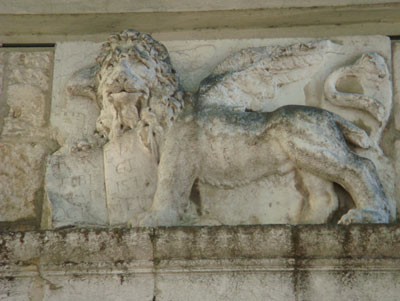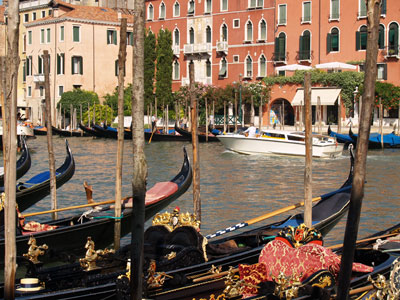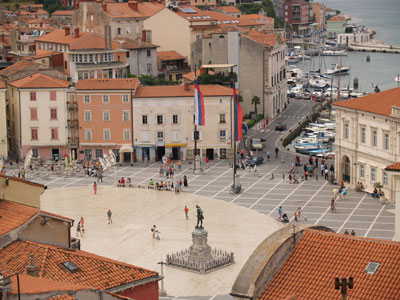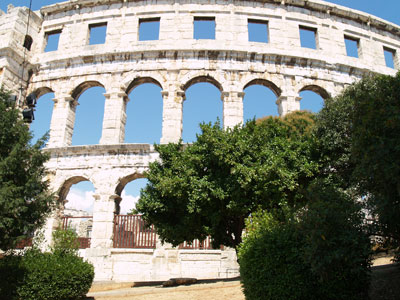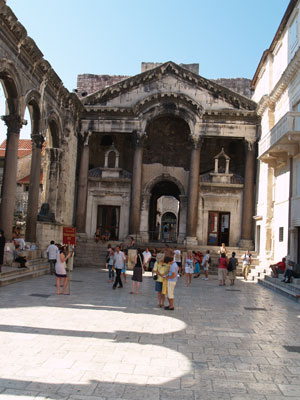The Adriatic Coast — In the wake of the winged lion
by Yvonne Horn, Contributing Editor
The winged lion of Venice, sculpted in stone, stood high above us just beneath the tip-top bronze bell of St. Mark’s Torre dell’Orologio, looking down on the populace as if it owned the world.
My grown daughter, Joanne, and I had come to Venice to board Windstar Cruises’ Wind Star — an appropriate starting place, as our week-long August ’08 voyage would trace a long stretch of Adriatic coastline systematically conquered by the Venetian Republic during its reign of supremacy. From the beginning of the 13th century until Napoleon Bonaparte came marching in, Venice marked its path with the republic’s signature logo, St. Mark’s winged lion.
Spotting winged lions at ports of call along the way added a “Where’s Waldo?” element to our coastal journey as we found them (“Look, there’s another one!”) peppering city entrance arches, bell towers, fortifications and imposing edifices.
Choosing a cruise
Many cruise ships furrow the seas between Venice and Dubrovnik with varying itineraries and ports of call. For our intended voyage, Wind Star was a perfect match, its small size enabling it to duck into anchorages where larger cruise vessels dare not maneuver. And, with only 148 passengers maximum, time ashore could be personalized.
When the winds are right, Wind Star’s sails billow, allowing the ship to travel in the ageless way of the Adriatic, as documented in the paintings and museum artifacts we would see along the way.
Another reason for our choice of vessels — fun and games. At the drop of an anchor, Wind Star opens its sports deck, hauling out water skis, snorkeling gear, sunfish sailboats, kayaks and all manner of equipment for frolicking in the winged lion’s ancient seas.
We’d touch but a token of the 1,246 islands scattered helter-skelter over what astronauts claim to be the planet’s bluest sea. Our first port of call was Koper, one of the oldest towns in Slovenia. (With but 29 miles of coastline, Slovenia’s presence on the Adriatic is often overlooked, with that of Croatia receiving all the press.)
From Koper, we continued on to the Croatian ports of Pula, Opatija, Zadar, Split and Korcˇula before oh-so-reluctantly saying good-bye to our pursuit of the winged lion in Dubrovnik.
Beginning in Venice
No one would readily choose August as the perfect month to visit Venice, yet meshing two busy calendars with Windstar’s schedule made Venice — at its most sweltering and tourist-laden — our sole option.
A water taxi whisked Joanne and me from the airport to our hotel’s dock on the Grand Canal. Joanne, in her search on Expedia for a place to headquarter, could not have arrived at a better choice for our 2-night stay than Hotel dei Dragomanni (fax +39 041 2778984 www.hoteldragomanni.com), a sublimely located, 17th-century residential palazzo lovingly transformed into a 23-room, 4-star boutique hotel. We paid a total of $588 for our 2-night stay, including a lavish breakfast.
It was Joanne’s second visit, my first, to this most unique of cities. Although I’d been to Venice in my reading-fueled imagination, I was unprepared for the enchantment of its palazzi-lined canals, zillions of arched bridges and pedestrian-only peacefulness.
Elbow to elbow, tourists swamped St. Mark’s Square. A line the length of the equator wound toward the basilica’s entrance, scratching that “must see” off our list. Instead, we purchased museum passes ($41 each; to book in advance, visit www.venice-museum.com) that gave entry to the Doge’s Palace and a bevy of other museums.
Directly across the square from the Doge’s Palace (the Republic’s ducal residence and political center until Napoleon put an end to it all in 1797), we had the Museo Correr, with its Venetian armory and naval history and art displays, practically to ourselves. Another favorite was Ca’ Rezzonico, a vaporetto ride away, where objects designed for a great palazzo were so displayed, with the unrelated surprise, on the third floor, of a reconstructed 18th-century pharmacy complete with wooden panels and labeled china apothecary jars.
The maddening crowds were easily escaped, as most centered around the environs of St. Mark’s Square. Exploration via canal pathways, uncounted bridges and the vaporetto landed us in interesting neighborhoods, such as the Jewish Ghetto, where we lunched at a sidewalk table on wondrously ripe slices of melon draped in prosciutto.
In a quiet square unexpectedly near our hotel, we were suddenly face to face with Teatro La Fenice, one of Europe’s great opera houses. All but destroyed in a 1996 fire, about which I’d read in John Berendt’s “The City of Falling Angels,” its restored interior featured vines, flowers, woodland animals and mythical creatures climbing toward a ceiling decorated with bare-breasted nymphs bathing in a gilded, sylvan stream. And there, mounted above the royal box, a winged lion!
The lion hunt continues
All too soon it was time to call for a water taxi to take us to the Wind Star, which was waiting at the dock with a departure scheduled for 5 p.m. We stood at the rail and watched Venice slip by as we entered San Marco Canal. Our odyssey in the wake of the winged lion had begun.
The two guidebooks we carried along (Rick Steves’ “Croatia & Slovenia” and Fodor’s identically named guide) had given fair warning that many of the Adriatic’s coastal towns have two parts: the Old Town (the reason for visiting) and the surrounding contemporary sprawl. Koper was no different, except that its historic center, too, had seen unfortunate modern intervention.
A walk from the dock into its ancient square evidenced no reason for loitering, even had it not been Sunday morning with everything closed. Its one exception was the Praetorian Palace, city hall at the time of the Venetian Republic. Winged lion noted.
While we were searching the posted bus schedule, a shuttle taxi stopped at the curb. Yes, our “sign language” conversation confirmed, its destination was Piran. Off we went on a seaside tour, the shuttle presenting the opportunity to talk with locals being picked up and dropped off at various stops along the route.
Piran, gem of the Slovenian Adriatic, gets its name from the Greek word for fire, pyr, because of the beacons placed on rock outcroppings there during Greek and Roman times to guide ships into safe harbor.
A short walk from the shuttle stop took us to a square of gleaming marble, its center marked by a statue of Piran-born Renaissance composer and violinist Giuseppe Tartini. At one corner of the square stood a miniature gem of a classic Venetian Gothic palace. On its front was a winged lion relief, inscribed with the words Lassa pur dir (“Let them talk”).
Legend has it that a rich Venetian merchant set up his girlfriend in the little palazzo. Gossiping tongues wagged, inspiring the merchant to get in the last word, etched in stone. It was our favorite Piran winged-lion sighting in a city littered with the Venetian beast.
From Tartini Square, we walked a steep, winding lane edged with ancient houses into Piran’s medieval heart, May 1 Square, continuing on to reach the 14th-century Cathedral of St. George, its campanile a miniature version of the one in St. Mark’s Square.
Piran, automobile and moped free, is a favorite destination for Slovenian and Italian vacationers who go to enjoy the crystal-clear, warm Adriatic.
Pula
Pula, at the southern tip of the Istrian Peninsula, was far less lion-littered than Piran, but it laid claim to one of the most interesting we spotted, on an archway’s supporting column, a very small lion enclosed in a circle with a crosswise bar sculpted across it. Meaning what, I wasn’t sure. No lions allowed?
Lions were certainly allowed in Pula’s Roman amphitheater. Reminiscent of Rome’s Colosseum, it was built in the first century to hold some 25,000 cheering fans. Today it is one of the world’s best preserved.
The arena marks the entry to Pula’s Old Town, where important Roman-era features, including the Temple of Augustus built during the reign of Augustus Caesar, can be found along with a plentiful array of Venetian artifacts. A triumphal arch, the Arch of Sergius, marks the edge of the original Roman town.
A life-size bronze statue of James Joyce sitting at a café table is located to the left of the archway, his nose gleaming, thanks to the multitudes of passersby who have rubbed it for good luck. Down on his own luck, Joyce spent some months in Pula in 1904-1905 teaching English to Austro-Hungarian officers.
Opatija
James Joyce’s stay would have been during the golden age of the Austro-Hungarian Empire, a time in which our next port of call, Opatija, found itself transformed from a sleepy seaside village nestled beneath towering mountain peaks into the sunny playground of choice for the European elite. So it remained for over 150 years. Today, while still exuding charm, Opatija carries an air of faded Belle Époque elegance.
With the Wind Star offshore, tenders delivered us to a dock steps away from one of Opatija’s grand villas, Angiolina, surrounded by an impeccably kept botanical park. From there, Joanne and I set out to walk as much of the city’s nearly 12-kilometer scenic seaside promenade, the Lungomare, as the day’s heat would allow.
Along the way, villas that appeared grand from a distance proved abandoned at closer view. Yet there were coves filled with sleek yachts as well as hotels with guests taking water exercise classes in swimming pools.
Steps led down to rocky, private beaches chockablock with swimmers and sunbathers. And, always ahead, there were grand views of mountains and sea.
By noon we’d had enough and returned to Wind Star’s tender, waiting to whisk us back for an umbrella-shaded lunch on the Veranda Deck.
Zadar
Our ship sailed south along the stark and desolate Kvarner coastline toward Zadar, Dalmatia’s capital for more than 1,000 years. We docked next to a 230-foot stretch of quay outfitted with 35 pipes comprising a sea organ, the wind and sea providing a concert of whistles and melancholy chords.
Zadar, 3,000 years old, has suffered terribly in its most recent years. A world war, decades of communism, and Croatia’s devastating war for independence has left many parts of town dreary and many precious artifacts and monuments lost. In spite of that, we found a trove of winged lions, remnants of a time when Zadar was the Venetian Republic’s largest city fortress. There were many on buildings in a small, tree-shaded park edging the Riva, as Croatian seaside promenades are called.
On the other side of the city, in a park above the Square of Five Wells (a system of cisterns built by the Venetians), a magnificent winged lion graced the stones of an isolated well. Most magnificent of all was the one in the center of the Land Gate, the triumphal arch entrance into the city, considered to be one of the finest Venetian-era monuments in Dalmatia.
Split
Wind Star’s daily schedule called for setting sail in the early evening; with port arrivals at 8 a.m., this allowed for full days of exploration on shore. A delight, for me (but not for Joanne, who prefers to sleep in), was to be on deck in the morning light, coffee cup in hand, watching the coastline go by while waiting for the day’s port to come into view.
Entering Split’s harbor precisely on the hour, Wind Star maneuvered into its docking space in the company of local ferries. A short walk away was our reason for visiting Split: the 3rd-century Diocletian’s Palace, a UNESCO World Heritage Site.
Much remains of the original palace, including a pillared courtyard where the megalomaniacal yet astute leader of the empire received homage from his subjects. Most interesting, however, was the tour of the palace cellar, used for centuries as a garbage dump. Now excavated, it provided a fascinating glimpse of how palace life was organized.
We expected to see but a few winged lions here, as the Venetian Republic was able to hold only sporadic control over the city; we found one crumbling example. A find of a different kind was the splendid Ethnographic Museum. Although founded in 1910, in 2005 it opened in new quarters, housed within the palace walls with displays that bring to life the days of the ordinary people of early Dalmatia.
There were winged lions aplenty, however, in nearby Trogir, as would be expected in a city occupied by the Venetians for nearly four centuries. Our guidebooks promised a tiny town packed with medieval architecture and surrounded by water, located only 12 miles from Split. With the bus station conveniently located across the street from the dock, we were soon on our way.
A short bridge ties Trogir to the mainland, immediately leading visitors to the town square’s wealth of 13th- to 17th-century historical buildings, including the Cathedral of St. Lawrence with its mixture of Gothic, Venetian Gothic and Renaissance architectural styles. Across the square sits a delightful vine-draped loggia, where the city’s old folk gather to sit, comment on passersby and discuss the news of the day.
Twisting lanes lead off the square, making for delightful wandering and ending up at the harbor-front Riva, lined with sidewalk cafés on one side and sleek megayachts at berth on the other.
Korcˇula
In the early evening we departed Split, threading our way south through the coastal islands. Our destination was Korcˇula, the sixth largest of the Adriatic islands, containing a walled town likened to a miniature Dubrovnik (minus the hordes of humanity that we would encounter there the next day).
Delightful Korcˇula, which Joanne and I voted, hands down, as our favorite port outside of Venice, was unlike the other medieval towns we visited. While the others were crossed by maze-like alleys, Korcˇula’s plan followed a herringbone pattern, with narrow side streets fanning out on either side at a curved angle so as to allow refreshing maestral sea breezes in while keeping the bad jugo wind out.
Thirteenth-century walls enclose the city, built to withstand foes of Venice. A noble staircase leads to the Great Land Gate which, in turn, opens to Franjo Tud¯man Square, named in 2001 for the first president of independent Croatia. Delightful medieval buildings surround the square, one housing a museum of eclectic artifacts, ranging from a ceremonial necklace from Mother Teresa to drawings by Leonardo da Vinci.
Local legend says that Marco Polo was born in Korcˇula. True or not, there is a classy little shop close to where he supposedly lived that stocks all sorts of gift items related to his explorations.
With plentiful winged lions spotted and satchels of herbs inspired by Marco Polo purchased, we adjourned to a tree-shaded sidewalk café just outside the city walls for a glass of local wine. In the sparkling sea, sailboats and windsurfers danced around the Wind Star, anchored offshore.
Dubrovnik
The next morning, docked at Dubrovnik’s port, we were greeted with a preview of what was in store for us that day. Two megacruise ships bookended a dwarfed Wind Star, already unleashing their thousands to be bused to the walled city.
If Venice in August is best avoided, the same is true in spades for Dubrovnik. Hordes, of which the megaships could be blamed for but a fraction, pushed against each other to enter Pile Gate, and the city’s gleaming limestone main street, polished by centuries of walkers, was packed shoulder to shoulder.
We made our way to a staircase leading to the ramparts, picking up an audio guide as we paid our fee (15 kuna, or $3). Gorgeously situated on a sweet curve of sea, Dubrovnik, even when overrun by tourists, deserves its reputation as one of the world’s most beautiful walled cities.
Under a sweltering sun, we walked the crowded ramparts, pausing to hear tales of the city’s astounding history as we looked down on elegant belltowers, copper domes, tiled roofs and gardened backyards.
So ended our Wind Star odyssey. We traveled from Venice to Dubrovnik, some 700 nautical miles, in seven days. How time and distance fly when one is in pursuit of the winged lion!
The details
Windstar Cruises has scheduled seven departures in the Adriatic for 2009, the first departing June 7, the last Sept. 6. Sailings both begin and end in Venice, replacing 2008’s Venice-to-Dubrovnik itinerary. Although some ports have been added or changed, the new schedule avoids the difficulty of arranging air transportation out of Dubrovnik.
Three of the sailings are on Wind Star and Wind Spirit, identical sister ships each carrying a maximum of 148 passengers. Windstar Cruises’ newest ship, Wind Surf, carrying a maximum of 312, is scheduled for the remaining four. The 2009 rate starts at $2,749 per person. Repeat Windstar customers are eligible for discounted rates and specials; we paid $1,999 per person.
For more information, contact Windstar Cruises (Seattle, WA; 800/258-7245, www.windstarcruises.com).


